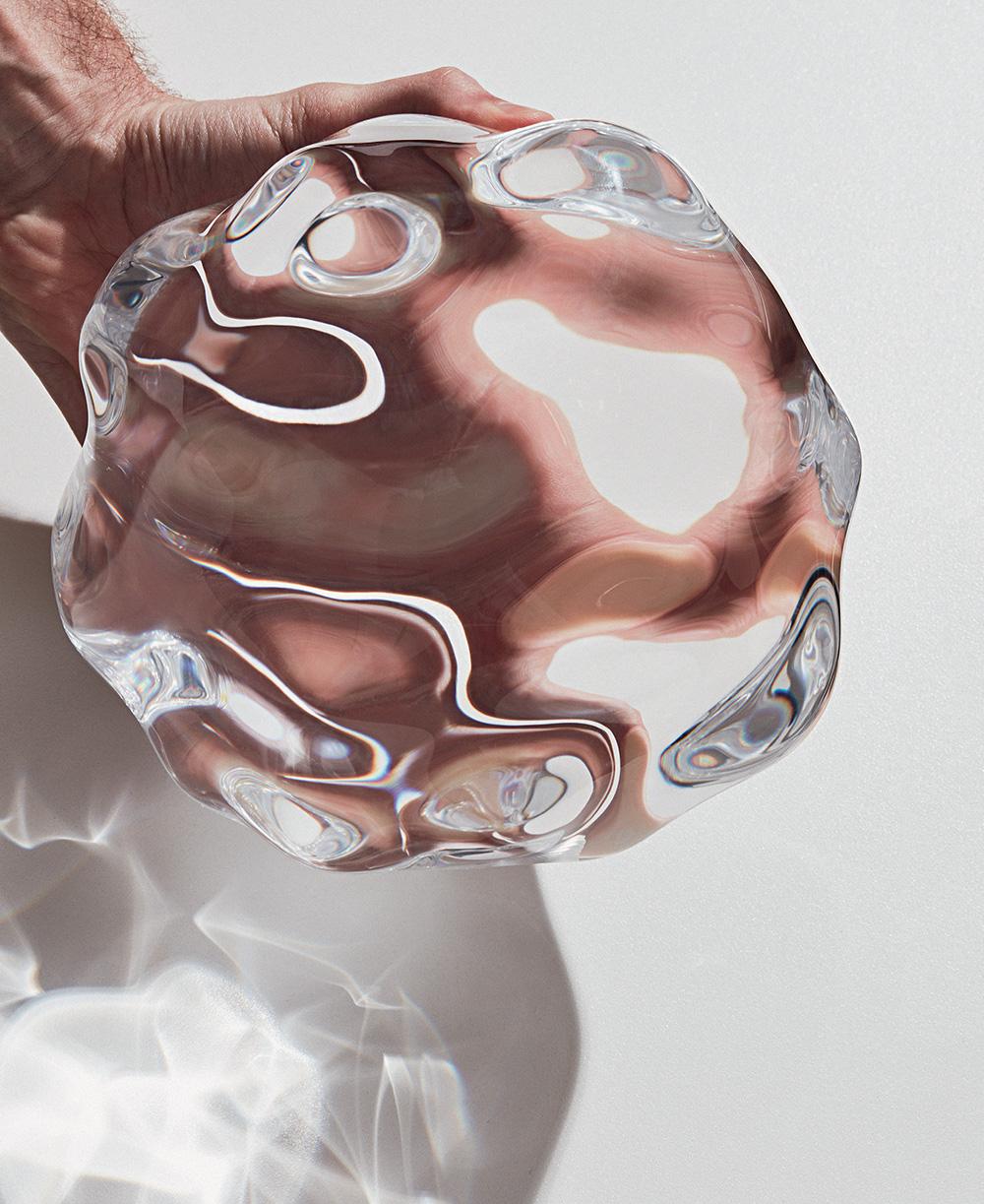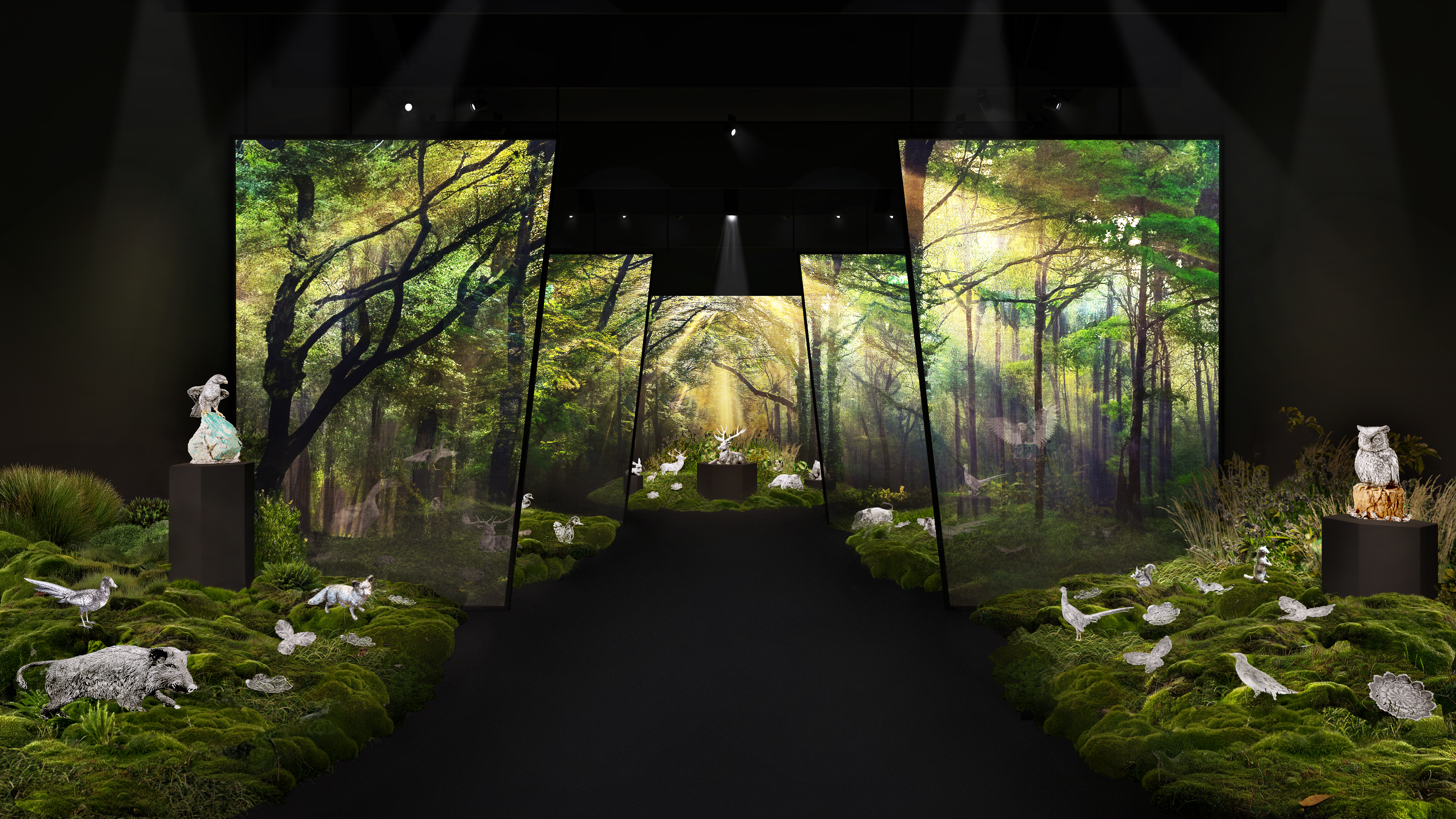Layer unveils giant installation for Cosentino at Milan’s Central Station
Opening during Salone del Mobile, Raytrace is inspired by the interplay of light and water

In an enormous, clinically clean facility in Almería in Spain (just one of seven it operates in the city), Cosentino captures and compacts geological time, magicking a marble-like material from mineral dust using the most advanced industrial science. For the past 12 years, it has been using Salone del Mobile to showcase what it can do with its time-crunching, 200m-long ovens, collaborating with the Campana brothers and Antonio Citterio among others. This year it is upping the ante, certainly in terms of scale and technical ambition. Raytrace, a giant installation that will take over a vaulted warehouse at Milan’s Central Station, is a collaboration with Benjamin Hubert’s London studio, Layer.
Its interior made aquatic by shifting patterns of light, the piece is a triangular tunnel covered inside and out in 3.5m by 1.5mm slabs of Dekton, a super-hard material Cosentino conjures from ingredients usually used in the production of glass and porcelain.

One of the 29 undulating glass spheres which will be used to create caustic patterns on the interior of the Raytrace installation in Milan
Hubert developed the concept after a visit to the dedicated Dekton factory. ‘It’s a designer’s dream,’ he says. ‘The process is highly technological but quite craft-based as well; it’s an intriguing split. And part of that process is removing any traces of water content from the material using incredible heat and pressure.
‘The idea of the installation was to reintroduce the water, or at least the light patterns you get from water, the effect of light playing on a bridge over a river. It’s something that always captures the imagination.’ Achieving that effect has taken some time, effort and algorithmic trickery. ‘We wanted to get the maximum effect from the smallest thing,’ says Hubert. ‘Initially we tried using a thin layer of moving water on glass but it just felt too literal. Then we thought about the way a glass sphere can scatter light.’

Sketches by Hubert of some of the water-inspired patterns on which the tunnel installation is based
Computers were deployed to design five different types of glass spheres that could create the kind of caustic patterns Hubert and his team were after. The final installation will feature 29 of these spheres, rotating under the cool light of 87 LEDs. The mirrors at each end of the tunnel should amp up the aquatic intensity and Hubert is confident that the effect will be intense and infinite in its variety. Meanwhile, the tunnel’s exterior ‘will be hit with video-imaging lights, a pure white block with no hot spots,’ Hubert says. ‘So there is refraction on the inside and reflections on the outside, and optical illusions wherever you look.’
Cosentino has managed to slim down Dekton since its creation in 2012, and Raytrace will be clad in a new ultra-thin version of the material. Cosentino vice-president Santiago Alfonso Rodriguez hopes it will alert visitors to the full potential of Dekton; both architectural – it’s been used on the exterior of Ron Arad’s new Totzeret Haaretz in Tel Aviv – and domestic. The 4mm-thick product’s lighter weight means it can be used on kitchen doors and bathroom walls. Raytrace is a kind of monument to the collaborators’ ambition and technical nous.

The tunnel will be made of a matt white ‘Zenith’ Dekton, while the installation’s floor will feature a glossy grey ‘Spectra’ Dekton
‘It is an ambitious project and it’s one you sort of have to suspend disbelief on,’ says Hubert. ‘It’s hard to know what you will see until it is finished. But Cosentino just jumped right in. At every turn they have said, “Yes, we can do this.” So we just had to deliver.’ And Hubert hopes it is a piece visitors will take time to experience rather than quickly Instagram and move on: ‘I’m hoping that people will be drawn through.’
Wallpaper* Newsletter
Receive our daily digest of inspiration, escapism and design stories from around the world direct to your inbox.
As originally featured in the May 2019 issue of Wallpaper* (W*242)
Discover more from Salone del Mobile here

A render shows the 25m-long, 6m-tall tunnel. Clad in a new, super-thin Dekton, it will feature caustic patterns on the inside and reflections on the outside

Benjamin Hubert inside Raytrace at Milan’s Central Station.
INFORMATION
Raytrace is on view from 9-14 April. For more information, visit the Ventura Projects website, the Layer website and the Cosentino website
ADDRESS
Ventura Centrale
via Ferranti Aporti 27
Milan
-
 Eight designers to know from Rossana Orlandi Gallery’s Milan Design Week 2025 exhibition
Eight designers to know from Rossana Orlandi Gallery’s Milan Design Week 2025 exhibitionWallpaper’s highlights from the mega-exhibition at Rossana Orlandi Gallery include some of the most compelling names in design today
By Anna Solomon
-
 Nikos Koulis brings a cool wearability to high jewellery
Nikos Koulis brings a cool wearability to high jewelleryNikos Koulis experiments with unusual diamond cuts and modern materials in a new collection, ‘Wish’
By Hannah Silver
-
 A Xingfa cement factory’s reimagining breathes new life into an abandoned industrial site
A Xingfa cement factory’s reimagining breathes new life into an abandoned industrial siteWe tour the Xingfa cement factory in China, where a redesign by landscape specialist SWA Group completely transforms an old industrial site into a lush park
By Daven Wu
-
 Eight designers to know from Rossana Orlandi Gallery’s Milan Design Week 2025 exhibition
Eight designers to know from Rossana Orlandi Gallery’s Milan Design Week 2025 exhibitionWallpaper’s highlights from the mega-exhibition at Rossana Orlandi Gallery include some of the most compelling names in design today
By Anna Solomon
-
 Bentley’s new home collections bring the ‘potency’ of its cars to Milan Design Week
Bentley’s new home collections bring the ‘potency’ of its cars to Milan Design WeekNew furniture, accessories and picnic pieces from Bentley Home take cues from the bold lines and smooth curves of Bentley Motors
By Anna Solomon
-
 StoneX partners with Wallpaper* for material alchemy at Milan Design Week and beyond
StoneX partners with Wallpaper* for material alchemy at Milan Design Week and beyondThe natural stone purveyor teams up with Wallpaper* for a three-year partnership of material adventures, starting with an exhibition at Triennale di Milano
By Simon Mills
-
 David Rockwell’s Milan Design Week presentation is a love letter to cork
David Rockwell’s Milan Design Week presentation is a love letter to corkRockwell Group’s Casa Cork installation showcases this under-appreciated material, which is infinitely recyclable and sequesters carbon for decades
By Anna Solomon
-
 Emerging galleries to discover during Milan Design Week
Emerging galleries to discover during Milan Design WeekWallpaper’s Milan editor has the inside track on the younger design galleries coming to town
By Laura May Todd
-
 Buccellati brings the forest and Furry Animals to Milan Design Week
Buccellati brings the forest and Furry Animals to Milan Design WeekThe jewellery and silverware maison falls back on tradition for its Milan showcase, presenting its now-emblematic collection of intricately crafted creatures
By Laura May Todd
-
 Where next for Salone del Mobile? Maria Porro on the future of the world’s biggest furniture fair
Where next for Salone del Mobile? Maria Porro on the future of the world’s biggest furniture fairAhead of Salone del Mobile 2025 in Milan, we sit down with its president to talk design, data and forging the event’s future in a fast-changing world
By Hugo Macdonald
-
 What to see at Milan Design Week 2025
What to see at Milan Design Week 2025A guide to some of the events the Wallpaper* team is checking out at Milan Design Week (7–13 April) – from public installations and major launches to standout venues and must-see exhibitions
By Hugo Macdonald